Philippine Marine Corps
| Philippine Marine Corps Hukbong Kawal Pandagat ng Pilipinas Infantería Marina de las Filipinas | |
|---|---|
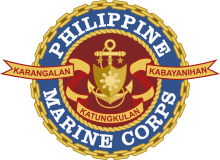 Seal of the PMC | |
| Active | November 2, 1950 |
| Country |
|
| Branch |
|
| Type | Marine corps |
| Size | 8,300[1] |
| Part of |
|
| Garrison/HQ | Fort Bonifacio, Makati City, Philippines |
| Nickname(s) |
PMC, Philippine Marines "The Few, The Proud, The Marines" "The Best in Soldiery" |
| Motto(s) |
Karangalan' Katungkulan, Kabayanihan ("Honor, Duty, Valor") or ("Honor, Deber, Valor") |
| Colors | Scarlet, Gold and Blue |
| Anniversaries | November 7 |
| Engagements |
Communist Insurgencies Islamic Insurgencies, Counter Insurgencies-Terrorism, Civilian Military Operations, International Peace Support and Humanitarian Relief Operations, UN Peacekeeping Operations |
| Commanders | |
| Commandant of the Philippine Marine Corps |
|
| Insignia | |
| Flag |
 |
| Battledress identification patch |
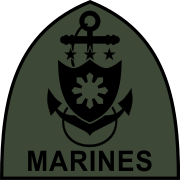 |
| Emblem |
 |
The Philippine Marine Corps (PMC; Filipino: Hukbong Kawal Pandagat ng Pilipinas; Spanish: Infantería Marina de las Filipinas), is the marine corps of the Philippines, a naval infantry force under the command of the Philippine Navy. It is in charge of manning garrisons in shoals like Ayungin Shoal where a marine detachment is stationed on the grounded BRP Sierra Madre. It conducts amphibious and expeditionary warfare, as well as special operation missions.
History
"The task of training these young men into Marines is vested upon us. Today, as we start training them, we will be striking the first hammer blow in forging the "cutting edge" of the Armed Forces."
On orders from President Elpidio Quirino and Ramon Magsaysay, then Secretary of National Defense, the Corps was organized on November 7, 1950, as A Company of the Philippine Fleet's 1st Marine Battalion and then headquartered in Cavite City, in Naval Base Cavite. Personnel from the United States Army and United States Marine Corps helped train the very first Philippine Marines in combat and amphibious duties in Fort Bonifacio in Makati City and in various other locations. Lieutenant (senior grade) Manuel Gomez was its first commandant, with then Lieutenant (junior grade) Gregorio Lim assisting him, with six other officers (4 seconded from the Navy and two from the Philippine Army) joining them, several of these officers being veterans of the Second World War.
Their hard work and training would pay off as the Marine Company conducted its first amphibious landing on April 19, 1951 in Umiray, Quezon, and took part in battle for the first time on June 4 of the same year in Nueva Ecija against communist rebels. These and other notable battles in various parts of the country, as well as overseas deployments to Korea, led to the Navy's decision to complete the 1st Marine Battalion with the raising of B Company in 1955 and the Headquarters and Service Company also in the same year, thus the marine battalion of one HQ company and two marine rifle companies, with now LCDR Lim in charge, was finally complete. (November 7, the date of the 1955 formal raising of the 1st Marine Battalion, is the official date of the Corps Birthday to this very day.)
Further marine companies and a weapons company would later be formed to augment the expansion of the force in the 1960s, and the abilities even expanded to VIP protection, and would also see the raising of its very own drum and bugle corps. The Marines would see themselves in action in securing the Spratly Islands in 1971 and in combating Muslim separatist forces and a strong New People's Army in the following years as the force became the Philippine Marine Brigade with the formation of the 2nd and 3rd Marine Battalions, the Headquarters Service Group, the 1st Provisional Tactical Battalion which saw action in Mindanao against Islamic separatists, and the Marine Training Group, later the Philippine Marines Training Group.
To highlight these changes the force was, in 1976, renamed as the Philippine Marines.
As the 1980s arrived, the force expansion was accompanied by battles against both communists and armed Islamist rebels all over the country, and in 1986 even took part in the successful People Power Revolution. The latter years would also see them in action as one coup d'état after another was launched against the Corazon Aquino administration, all ending in failure. It also saw Rodolfo Biazon becoming the first and only Marine Corps general to head the Armed Forces as Chief of Staff after a fruitful term as Superintendent of the Philippine Military Academy, the first and only Marine Corps general officer to occupy the office so far in PMA history.
The 1990s would see further expansion as the force, as part of the Philippine Navy, became the Philippine Marine Corps in 1995 as the force turned 45 years old. The early 2000s (decade) would see the Marine Corps once more facing not just communists and Islamic militants but also terrorist groups as well.
Formation
The Philippine Marine Corps is organized into three maneuver brigades, a Combat Service and Support Brigade (CSSB), a Headquarters for 7th Marine Brigade(R)NCR, and independent units such as the Force Recon Battalion (FRBn) and the Marine Security and Escort Group (MSEG). The three maneuver brigades provide administrative and logistical support to the units assigned to them, while the CSSB acts as a training and administrative command for the Field Artillery (FABN) and Assault Armor (AABN) battalions.[2]
Marine Rifle Battalion
The Philippine Marine Corps has twelve regular Marine Battalions.[3] Three battalions are assigned to each of the three maneuver brigades and a single battalion is rotated back to the Marine headquarters for refit and retraining for at least six months up to one year before redeployment to operational areas in the southern Philippines.[4]
Each of the twelve battalions is organized into three rifle companies and a headquarters and service company. The battalions are augmented with elements of other units, such as artillery, armored vehicles or watercraft, for specific tasks. These units, when supported with assets from the CSSB form the core of a Marine Battalion Landing Team (MBLT). A combat engineer unit from the Naval Combat Engineering Brigade (NCEBde) or Seabees can be attached for construction, survivability, mobility and countermobility support. Elements from the Marine Special Operations Group (MARSOG) can also be attached for reconnaissance and unconventional warfare support to make it Special Operations Capable (SOC).[4]
Marine Reserve Units
The 7th Marine Brigade (Reserve) was activated as a provisional unit of the Philippine Navy on 22 October 1996 pursuant to Section I General Order No. 229 ONA dated 21 October 1996 during the term of Vice Admiral Pio Carranza AFP as FOIC. PN. It was assigned to the Naval Reserve Command and placed under the operational control of the Commandant, Philippine Marine Corps.[2] The 7th Marine Brigade (NCR) is the Main Active Reserve Force of the Philippine Marine Corps with 3 operational Marine Battalions Composed of active men & women from different backgrounds & experiences, that are integrated to the regular & special units of the Corps. Given the same (MOS) training that enable the 7th MBde personnel to have interoperability with the rest of the Corps. Administrative control rest on the Naval Reserve Command (NCR), Philippine Navy while Operational is with the Philippine Marine Corps (MC9). (Motto: Always Faithful, Always Ready, Nickname: Shadow Warriors)
Field Artillery Battalion
The Field Artillery Battalion (FABN) is currently organized into a Headquarters and Service Company and several howitzer batteries which are attached to the maneuver brigades to support their operations. It is equipped with both the M101A1 howitzer and the OTO Melara Model 56/14 pack howitzer. The unit also provides a limited air-defense capability through a token number of Bofors 40 mm L/60 guns.
Assault Armor Battalion
The Assault Armor Battalion (AABN) contains a Headquarters and Service Company, an Armor Maintenance Company (Armor Mnt Co), an Assault Amphibian Company (AAV Co), and a Light Armor Vehicle Company (LAV Co). It is tasked with providing the maneuver brigades with armored assets to support their operations. The unit's inventory consists of LAV-150s, LAV-300s, LVTP-5s and LVTH-6s. None of the LVTP-5s are currently in service but the Marines have been able to recondition four of the LVTH-6s for their use.
Marine Force Reconnaissance Battalion

The Force Marine Recon Battalion was first activated on August 19, 1972[5]
The Force Recon Battalion (FRBn) is organized into a Headquarters, Service and Training Company and four Recon Companies, numbered 61st, 62nd, 63rd,and 64th. Each of these companies is attached to a Marine Brigade to serve as quick maneuvering force. It specialises in sea, air and land operations, like its counterpart in the Naval Special Warfare Group of the Philippine Navy, ranging from reconnaissance, close combat, demolition, intelligence and underwater operations in support to the overall naval operations.(Swift Silent Deadly)
Marine Security and Escort Group
The Marine Security and Escort Group (MSEG) is responsible for security on naval facilities, vital government installations and protection of VIPs. The unit also fills most of the PMC's ceremonial duties, and mounts the honor guard at the Rizal Monument in Rizal Park, Manila.
Marine Drum and Bugle Team
The Marine Drum and Bugle Team (MDBT) is the prime musical unit of the Philippine Marine Corps and the only Drum and Bugle Corps in the entire Armed Forces of the Philippines that provides marching band and musical services in support of the ceremonial and morale activities of the Corps. This is patterned along the lines of the United States Marine Drum and Bugle Corps and is stationed at Marine Barracks R. Brown in Makati City.
Marine Scout Snipers
The Marine Scout Snipers (MSS) is the very first unit in the Armed Forces of the Philippines dedicated exclusively to sniping and marksmanship. The Scout Snipers are notable for being able to effectively hit and neutralize targets at 800 metres (2,600 ft) using only 5.56 mm rounds. The Marine Scout Snipers are renowned for the development and manufacture of their own weapon, the Colt M16A1 based Marine Scout Sniper Rifle.
Philippine Marine Corps Marine Silent Drill Platoon
Also headquartered in Makati City, this is the premier military drill team of the Corps and one of 4 such units in the AFP, patterned after the United States Marine Corps Silent Drill Platoon. Like its US counterpart it does a unique silent precision exhibition drill using the M1 Garand rifles with fixed bayonets demonstrating the Corps's professionalism and discipline in all events where it is a part of.

Major Equipment
Infantry weapons
| Picture | Model | Origin | Type | Caliber | Version | In Service | Notes | |
| Pistol | ||||||||
 | M1911 pistol | | Semi-Automatic Pistol | .45 ACP | M1911 | unknown | Standard army issue sidearm, mixed between former US stocks and new local sourced units made by Armscor company. Some pistols refurbished and upgraded by Government Arsenal. | |
| Submachine Gun | ||||||||
| | MP5 | | Submachine gun | 9×19mm | MP5A3 MP5A5 | unknown | Issued to Force Reconnaissance Battalion[6] | |
 | M3 Grease Gun | | Submachine gun | .45 ACP | M3A1 Upgraded | unknown | Some reserved units refurbished and upgraded with Picatinny rail, optical sights, and suppressors. Used by armored crew and support troops[7][8] | |
| Assault rifle | ||||||||
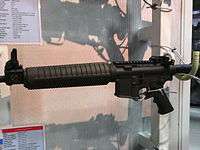 | M16 | | Assault rifle | 5.56×45mm | A1 A1 (enhanced) A1 Dissipator A2 | unknown | Standard infantry issue rifle, either made by Colt USA or Elisco Tool Philippines. Government Arsenal refurbishing M16A1-standard rifles to M16A1 (enhanced). | |
| | Night Fighting Weapons System | | Assault Rifle | 5.56×45mm | NFWS | unknown | Introduced in 2004, developed by the PMC based on M16A1 rifle after experiences in the MSSR. Used by Force Recon Battalion.[9] | |
| | M4 carbine | | Carbine | 5.56×45mm | Colt M4 & M4A1 Remington R4A3 | unknown 6,443 (+969) | Remington R4A3 to replace the M16A1 as the PMC's standard rifle. 6,443 units will be delivered to the PMC from the first batch of 50,629 delivered to the AFP.[10] More expected from additional orders made by AFP. Colt M4s are used by Force Recon Battalion. | |
| | HK416 | | Carbine | 5.56×45mm | D10RS & D14.5RS | unknown | Used by Force Recon Battalion[11] | |
| | CAR-15 | | Carbine | 5.56×45mm | M653 M653P | unknown | Used by Force Recon Battalion | |
| | M14 rifle | | Battle rifle / Designated Marksman Rifle | 7.62×51mm | M14 | unknown | Standard battle rifle, several were installed with optics and used as designated marksman rifles. | |
| | M1 Garand | | Semi-automatic rifle | .30-06 Springfield | M1 | unknown | Used for ceremonial purposes. Others distributed to ROTC units armed and trained by the Philippine Marine Corps. | |
| Sniper Rifle | ||||||||
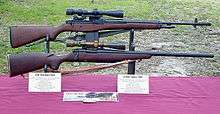 | M21 | | Semi-Automatic Sniper Rifle | 7.62×51mm | M21 | unknown | Standard sniper rifle | |
| | Marine Scout Sniper Rifle | | Semi-Automatic Sniper Rifle | 5.56×45mm | MSSR 1st Gen MSSR 2nd Gen MSSR 3rd Gen | unknown | Introduced in 1996, developed by the PMC based on M16A1 rifle.[9] Effective in primary to intermediate ranges. | |
| | Remington M700 | | Sniper Rifle | 7.62×51mm | M40A1 | unknown | Introduced the M700P in 2004, modified by the PMC to M40A1 standard to suit their requirements[9][12] | |
 | Barrett M95 | | Anti-Materiel/Heavy Special Applications Scoped Rifle | .50 BMG | M95 | unknown | Used by Marine Scout Snipers.[9] | |
| Machine Gun | ||||||||
| | FN Minimi | | Light machine gun | 5.56×45mm | Minimi | 76 | Standard Squad Automatic Weapon.[13] | |
| | M60 | | General-purpose machine gun | 7.62×51mm | M60E3 M60E4 | unknown >230 | Standard general purpose machine gun. 230 new M60E4 (Mk. 43) delivered in 2014. Several older M60E3 were refurbished to M60E4 standards by Government Arsenal. | |
| | M1919 Browning | | Medium Machine Gun | .30-06 Springfield | M1919A4 M1919A6 | unknown | Used for static/base defense, mounted on vehicles, including gun trucks, and training of auxiliary and reserve units.[8][14] | |
| | M2 Browning | | Heavy machine gun | .50 BMG | M2 M2A1 | unknown | Standard heavy machine gun. Either on tripod or vehicle mounted. | |
| Grenade Launcher | ||||||||
 | M203 | | Grenade launcher | 40mm | M203 M203A1 | unknown | Attached to M4/M4A1 and M16A1/M16A2 rifles. | |
 | M320 Grenade Launcher Module | | Grenade launcher | 40mm | M320 M320 stand-alone | unknown | Attached to HK416 carbine. Several units are in stand-alone system. | |
| | M79 | | Grenade launcher | 40mm | M79 | unknown | ||
 | Milkor MGL | | Grenade launcher | 40mm | M32A1 | unknown | in limited numbers[15][16] | |
| CIS 40 AGL | | Automatic Grenade launcher | 40mm | Standard | 0 (+8) | 8 ordered in 2014.[17] | ||
Anti-tank and Assault Weapons
| Picture | Model | Origin | Type | Caliber | Version | In Service | Notes |
|---|---|---|---|---|---|---|---|
| | Armbrust | | Anti-tank Weapon | 67mm | Armbrust AT | unknown | Sourced from Singapore, in limited numbers as an alternative to recoilless rifles.[18] |
| | M72 LAW | | Anti-tank Weapon | 66mm | unknown | unknown | In limited service with the Force Reconnaissance Battalion. |
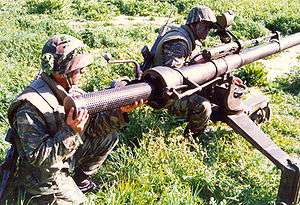 | M40 | | Recoilless rifle | 105mm | M40 | unknown | Vehicle mounted, mostly on M151 or MMPV vehicles. |
 | M67 | | Recoilless rifle | 90mm | M67 | unknown | Standard shoulder-mounted assault and anti-tank weapon. |
Night Vision Equipment
| Picture | Model | Origin | Type | Version | In Service | Notes |
|---|---|---|---|---|---|---|
| | AN/PVS-14 | | Monocular Night Vision Device | M914A | unknown | |
| | AN/PVS-7 | | Binocular Night Vision Device | - | unknown | |
| Night Optics Argus D-740 | | Night Vision Weapons Sight | D-740 | unknown | used on Night Fighting Weapon System Rifles[19] | |
| Night Optics Gladius D-760 | | Night Vision Weapons Sight | D-740 | unknown | used on Night Fighting Weapon System Rifles[19] | |
| Litton M845 | | Night Vision Weapons Sight | M845 Mk.II | unknown | used on Night Fighting Weapon System Rifles[19] | |
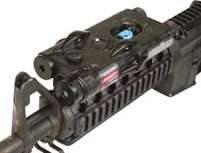 | AN/PEQ-2 | | Target Pointer/Illuminator/Aiming Light | - | unknown | |
Communication equipment
| Picture | Model | Origin | Type | Version | In Service | Notes |
| AN/PRC-150 Falcon II | | Manpack Combat Radio | RF-5800H-MP | unknown | Introduced in 2004. 15 units received in 2005, more units delivered in 2008[20][21] and 2011.[22] | |
| AN/PRC-152 Falcon III | | Handheld Combat Radio | RF-5800V-HH | unknown | Introduced in 2004. 103 units received in 2005, More units delivered in 2008[20][21] and 2011.[22] | |
Armored vehicles
| Picture | Model | Origin | Type | Version | In Service | Notes |
 | KAAV7A1 | | Armoured Personnel Carrier | KAAV7A1 | 0 (+8) | Delivery expected by 2 years & 6 months after the signing of the contract.[23] |
 | LVT-5 | | Amphibious Fire Support Vehicle | LVTH-6 | 4 | Previously out of service, refurbished and recommissioned in 2006 with armor upgrades. |
| | Commando | | Armoured personnel carrier | V-150 | ~18 | Delivery starting 1975,[24] at least 18 known in service[25] and 12 refurbished in 2007.[26] |
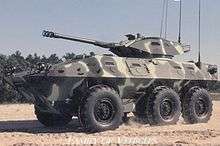 | LAV-300 | | Armored personnel carrier & Fire Support Vehicle | V-300 APC V-300 FSV | 12 11 | Introduced in early 90s. 23 in service as at 2012,[27] 1 FSV destroyed in enemy action. |
 | M35 Armored Gun Truck | | Armored Gun Trucks | M35 Gun Truck | unknown | Several M35 2 1/2-ton cargo trucks were converted to armored gun trucks by the PMC using armor plating from decommissioned LVT-5, acting as armored personnel carriers or armored escort vehicles.[28] |
Utility vehicles
| Picture | Model | Origin | Type | Version | In Service | Notes |
| Marine Multi-purpose Vehicle | | Light Utility Vehicle and Weapons Carrier | MMPV | unknown | To replace the M151, or as a cheaper alternative to the Humvee. Several are armed with an M40 106mm recoilless rifle[29] | |
.jpg) | Delta Mini Cruiser | | 1/4-ton Light Utility Vehicle | M1777 | unknown | Divided into several variants and series, including short and stretched utility and armed variants, and modified variants for specialized units. |
 | M151 | | 1/4-ton Light Utility Vehicle and Weapons Carrier | Standard | – | In Service, several carrying M40 106mm recoilless rifle. |
 | AM General HMMWV | | Light Utility Vehicle | M998A1 M1038A1 M1025A1 | unknown | Divided into several variants and series |
| | Maxi-Ambulance | | Light Utility Vehicle | M1152 | 4 | 23 delivered to AFP in November 2011,[30] PMC received 4 units. |
 | KM-45 Series | | 1 1/2-ton Utility Vehicle Field Ambulance | KM-450 KM-451 | <50 12 | 651 purchased by AFP on 2007, 61 units shared by Navy/Marines and Air Force[31] 60 km-451 field ambulance purchased by AFP in 2012, 12 went to the Marines. |
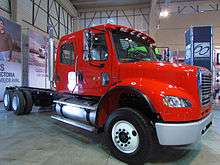 | Freightliner M2 | | Utility Truck | M2 106 Crew Cab | 6 | Hauler for Riverine Patrol Boat trailer, each with RPB trailer.[32] |
 | M35 Truck | | 2 1/2-ton Utility Vehicle | M35 | – | Divided into several variants and series. More delivered in 2013. |
.jpg) | KM-250 Series | | 2 1/2-ton Utility Vehicle | KM-250 | - | |
_5-ton_cargo_truck_heads_a_convoy_departing_Camp_Matilda%2C_Kuwait_crop.jpg) | M939 truck | | Heavy Utility Vehicle | M923 | – | Several delivered to AFP in 2013, several units for the Marines.[33] |
| KM-500 Series | | 5-ton Utility Vehicle | KM-500 | 12 | 155mm Artillery prime mover. 1st batch of 6 delivered 2012. | |
| Hydratek D2488 | | Amphibious Support Vehicle | D2488B | 10 | Acquired in 2015. | |
| | LARC-V | | Amphibious Support Vehicle | LARC-V | 5 | Most refurbished in 2006. |
| GKN Aquatrack | | Amphibious Support Vehicle | Aquatrack | 2 | Introduced in the mid 1990s. Originally owned by the Office of Civil Defense but under PMC stewardship. | |
Artillery
| Picture | Model | Origin | Type | Version | In Service | Notes |
| Mortar | ||||||
| M75 mortar | | 60mm Mortar | M75 | unknown | Several hundred units were produced as part of the AFP Self-Reliance Defense Posture Program starting 1977, several distributed for the PMC.[34] | |
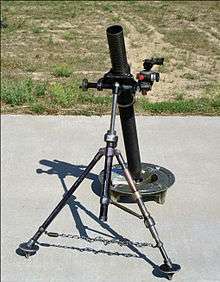 | M29 mortar | | 81mm Mortar | M29 | unknown | In service.[27] |
| Field Artillery | ||||||
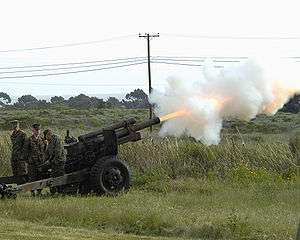 | M101 | | 105mm Towed Howitzer | M101 | ~23 | Total 150 delivered to the AFP, majority with the Army. Delivered in 1957-1958.[24] |
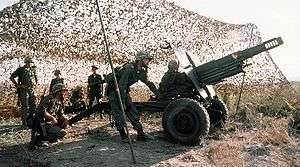 | Mod 56 | | 105mm Towed Howitzer | Mod 56 | ~20 | Total 250 delivered to AFP, majority went to the Army. Delivered in 1983.[24][25] |
Anti-Aircraft
| Picture | Model | Origin | Type | Version | In Service | Notes |
| | Bofors 40mm L/60 | | Anti-Aircraft gun | Single Naval Mk. 3 Twin Naval Mk. 16 | - | Formerly ship-mounted anti-aircraft guns, transferred to the PMC. Mounted on trailer carriages.[25][35] More being planned as the navy transfers more gun mounts to the PMC. |
 | Oerlikon 20mm gun | | Anti-Aircraft gun | Single Naval Mk. 10 | – | Formerly ship-mounted anti-aircraft guns, transferred to the PMC. Mounted of M35 2 1/2-ton trucks.[25][35] |
| | M2 Browning | | Heavy machine gun | Twin Naval Mk. 56 | – | Formerly patrol boat-mounted guns, either mounted on a naval gun tub fitted on an M35 2 1/2-ton trucks that tows the Bofors 40mm anti-aircraft gun trailers, or on trailer mounts.[25][35] |
Watercraft
| Picture | Model | Origin | Type | Version | In Service | Notes |
_2_come_ashore_with_two_simulated_detainees_to_be_turned_over_to_Mobile_Security_Squadron_3%2C_Det._33%2C_during_COMET_2007.jpg) | Riverine Patrol Boat | | Small unit riverine craft | 40' x 10'8" SURC | 6 | Similar but larger version of the SURC used by the US Marines produced by Silver Ships Inc., purchased under FMS worth $6.5 million and introduced in September 2013[36] |
Future
- As of September 2013, DND invited bidders for Amphibious Assault Vehicles Acquisition Project of 8 brand-new units of amphibious assault vehicles (AAV) with Integrated Logistics Support (ILS) for the Philippine Navy amounted to Php2.5B. Delivery is required for 850 days from the opening of the letter of credit. This acquisition is part of the PN's MRV/SSV or "Mother Ship" Project which will serve as platform for insertion of troops in beaches in an event of military siege.[37][38] Also, they are interested to purchase a Russian BMP-3F.[39]
- The Philippine Marines has a joint purchase with the Philippine Army for around 44,080 new body armor (Force Protection Equipment),[40] composed of basic vest, plate inserts and soft-ballistic panel and weighing between 5.8 kilograms to 6.8 kg.[41]
- A joint project between the Philippine Marines and the Philippine Army is the procurement of around 50,000 new rifles based on M16/M4/M4A1/AR-15 platform, and 5,500 close combat optics.[42][43] The PMC will get a fraction of the rifles and optics. The assault rifle acquisition project was awarded to Remington Defense for their Remington R4 carbine.[44]
- A joint project between the Philippine Marines and Philippine Army for the acquisition of 12 units of 155 mm towed howitzer and 280 rounds of 155 mm howitzer HE ammunition.[45]
- In January 2015, the Philippine Navy confirmed that the Marines will acquire an undisclosed number of M40 sniper rifles to replace their M14 rifle variants for marksmen to observe and engage targets at longer ranges.[46]
Marine Bases
- Marine Barracks Rudiardo Brown (Marine Base Manila), Fort Bonifacio, Taguig City, Metro Manila.[47]
- Marine Barracks Gregorio Lim (Marine Base Ternate), Ternate, Cavite
- Marine Barracks Arturo Asuncion (Marine Base Zamboanga), Zamboanga City
- Marine Barracks Domingo Deluana (Marine Base Tawi-Tawi), Tawi-Tawi
- Camp Gen. Teodulfo Bautista, Jolo, Sulu
Culture
The Philippine Marines share the traditions of both the US and Spanish marine units especially in the uniform and rank system. But the Corps has its own traditions as well.
Official traditions and customs
Core Values and Motto
Karangalan, Katungkulan, Kabayanihan (Honor, Duty, Valor) are not just the Marine Corps motto but also the main Core Values of the Philippine Marines of today, emphasizing the kind of values that service personnel of the PMC will always live on everyday.
PMC Seal
The seal incorporates the sun with its eight rays from the Flag of the Philippines, the anchor symbolizing the naval heritage and bond of the Corps as it is a part of the Philippine Navy, the closed loop rope (different from the rope in the USMC arms) symbolizing the links of Marines to one another and to show that a Philippine Marine once will be a Philippine Marine always, and the scroll showing the Marine Corps motto and Core Values: Karangalan, Katungkulan, Kabayanihan (Honor, Duty, Valor). As with the USMC, blue represents the naval heritage while the official Marine Corps colors of scarlet and gold are also present, forming the base of Marine Corps guidons, and all three form the basis for the battle color as opposed to the latter two which is the USMC color basis.
Battle Color of the Philippine Marine Corps
The battle color, maintained by Marine Barracks Rudiardo Brown in Fort Bonifacio, Makati City, Metro Manila, is in navy blue with two golden scrolls, one indicating the name of the corps at the top and the other, surrounding the anchor and the sun, indicating the Marine Corps motto and core values, all in red lettering. The battle color incorporates both the anchor and the sun with eight rays from the seal, but also includes the three stars of the national flag symbolizing the Philippines's three major island groups above the anchor. The color is similar to the one used by the USMC during the First World War.
See also
- Marine Corps
- Philippine Navy
- Philippine Army
- Philippine Air Force
- Armed Forces of the Philippines
- Military History of the Philippines
References
- Notes
- ↑ Wertheim, Eric. "Philippines Modernizing Navy to Counter Regional Threats". Retrieved 12 August 2015.
- 1 2 "Philippine Marine Corps (official website)". Archived from the original on September 13, 2002. Retrieved 2006-06-25.
- ↑ IISS (2012), p. 276
- 1 2 "The Philippine Marine Battalions". The Philippine Marine Corps. Archived from the original on June 30, 2010. Retrieved 30 July 2010.
- ↑ http://pmc.navy.mil.ph/organization.php#\. Retrieved 2015-04-30. Missing or empty
|title=(help) - ↑ GERMAN FIREARMS IN THE PHILIPPINES by Roman Deckert, seen Sep 24, 2008
- ↑ M3 Grease Guns Reissued
- 1 2 Philippine Marines Reintroduce Old Kit
- 1 2 3 4 The Philippine Marine Corps Scout Sniper Program
- ↑ AFP to Distribute 23,700 Units of Modern Rifles to Army and Marines
- ↑ Anti-Militarist Network Caught in the Act: H&K Selling Guns to Human Rights Abusers
- ↑ "On assignment in Zambo with Marine snipers". GMA News. 10 October 2013. Retrieved 30 December 2013.
- ↑ "P.6-B contract for 1,700 guns placed on hold". Inquirer.net. 2005-03-06. Retrieved 2015-10-02.
- ↑ The M1919 .30 cal MG: Alive and well in the AFP
- ↑ USMC’s New M-32s/ MSGLs: Hitting the Field
- ↑ Milkor grenade launcher
- ↑ Notice to Proceed
- ↑ "Armbrust in the AFP". Retrieved 6 June 2012.
- 1 2 3 "Night Fighting Weapon System". Security Arms.com. Retrieved 2015-10-06.
- 1 2 Harris Corporation Awarded $80 Million Contract to Provide Falcon II(R) Tactical Radios to Philippines Ministry of Defence
- 1 2 Radios, Helicopters for the Philippines
- 1 2 "Philippine Army is Expanding". Asia Pacific Defense. Retrieved June 9, 2011.
- ↑
- 1 2 3 "SIPRI arms transfer database". Stockholm International Peace Research Institute. Information generated on 29 December 2013. Retrieved 29 December 2013. Check date values in:
|date=(help) - 1 2 3 4 5 GlobalSecurity.org Philippine Marine Corps Equipment List
- ↑ Textron Marine & Land Systems Textron Marine & Land Delivers First Six Re-powered V-150 Combat Vehicles to Philippine Marine Corps
- 1 2 IISS (2012), p. 277
- ↑
- ↑
- ↑ "Military acquires 23 new Humvee units". BusinessMirror.com.ph. 2011-11-14. Retrieved 2011-11-15.
- ↑ Salarzon, JB: Special Report : P8 Billion na ang nagastos sa modernisasyon ng Army , Abante / Abante Tonight, August 2008.
- ↑
- ↑ Look at what I've stumbled upon!
- ↑ Danilo Lazo & Juanita Mercader. The AFP Self-Reliance Defense Posture (SRDP) Program: Leading the Nation Towards a New Direction (PDF) (Report). p. 151. Retrieved 2015-10-03.
- 1 2 3
- ↑ "US to turn-over 6 river craft to PHL Marines". GMA News. 2013-09-24. Retrieved 2013-12-29.
- ↑ "Amphibious Assault vehicle Acquisition Project" (PDF). Department of National Defense, Philippines. 2013-09-27. Retrieved 2013-10-04.
- ↑ "DND invites bidders for 8 Amphibious Assault Vehicles". AFPModernization.blogspot.com. 2013-09-29. Retrieved 2013-10-04.
- ↑ http://asian-defence-news.blogspot.com/2014/06/philippines-interested-in-russian-bmp-3f.html
- ↑ "Force Protection Equipment Acquisition Project for the Philippine Army and Philippine Marines Corps" (PDF). DND.gov.ph. Retrieved September 26, 2013.
- ↑ "DND wants US testing for soldiers' protection kits". Business Mirror. 2013-03-31. Retrieved 2013-04-27.
- ↑ "DND to purchase P1.7-B worth of body armors". ABS-CBN News. 2013-02-07. Retrieved 2013-04-27.
- ↑ "Invitation to Bid- Assault Rifles & Close Combat Optics". PhilGEPS Philippine Government Electronic Procurement System. 2013-02-09. Retrieved 2013-04-04.
- ↑ "Remington gets $47 million contract to make guns for Philippines". CNYCentral.com. Retrieved December 30, 2013.
- ↑ "Invitation to Bid for 155mm Towed Howitzer with Ammunition Acquisition Project" (PDF). DND.gov.ph. Retrieved December 30, 2013.
- ↑ Philippines' Marine Troops to replace M14 sniper rifles with new M40 7.62mm platform - Armyrecognition.com, 5 January 2015
- ↑ "The Philippine Marine Corps".
- Works consulted
- International Institute for Strategic Studies (IISS) (2012). The Military Balance 2012. London: IISS. ISSN 0459-7222.
External links
| Wikimedia Commons has media related to Philippine Marine Corps. |